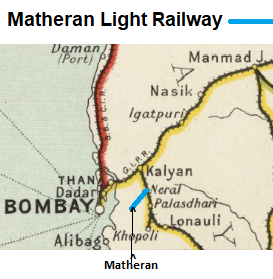Matheran Hill Light Railway


The Matheran Light Railway(MLR) was a 2ft/610mm narrow gauge(NG) mountain railway near Bombay (Mumbai). The privately financed line was 12 miles(19km) in length between Neral and Matheran and opened in 1907. At Neral there was an interchange with the broad gauge(BG) Great Indian Peninsula Railway ‘GIPR South East Mainline’ 20 miles(32km) south-east from Kalyan.
The line was owned by the ‘Matheran Steam Light Tramway Company’ who provided all the ‘rolling stock, locomotives and plant, and maintain the way and works.... the keeping and auditing of the Revenue Accounts being under the control of the ‘Great Indian Peninsula Railway Company’ (GIPR) [1].
The ‘Matheran Steam Light Tramway Company’ was established under the Indian Tramways Act of 1886 and the Matheran Tramway Order of 28th July 1904 by their Agents ‘Messrs. Sir Adamjee Peerbhoy and Sons’, Bombay [2]
The line ran from the GIPR station at Neral to Matheran and is in some records described as the Neral-Matheran Light Railway, also as the Matheran Hill Light Railway and the Matheran Tramway
A new Agreement dated 12 Aug 1918 transferred from the GIPR back to the MLR the “provision of Traffic and Telegraph staff and audit of the Revenue Accounts and Expenditure inclusive of supervision thereof”. It also confimed that “the Tramway shall be solely responsible for the provision of Rolling Stock. Locomotives, Machinery, Furniture, Fittings, Plant and Appliances necessary for the purpose of working the Tramway and for keeping the same in order and up to the standard of efficiency for such working.” [2]
Everard Richard Calthrop was the consulting engineer. Unusually for a railway for which he designed it was of 2ft/610mm narrow gauge(NG), with tight curves and 1 in 20 (5%) grades. [3]
History
Matheran was identified by Hugh Poyntz Malet, the then District Collector [4] of Thane district in May 1850. Lord Elphinstone, the then Governor of Bombay laid the foundations of the development as a future hill station. The British developed Matheran as a popular resort to beat the summer heat in the region [5].
The GIPR from Bombay had reached Thane in 1853 and Kalyan in 1854. The GIPR ‘South East Line’ from Kalyan reached Neral (which was to become the terminus of the MLR) in 1856. However there was no attempt to develop rail access to the Matheran Hill on the edge of the Western Ghats.
Unlike the other hill railways, the credit for setting up the railway line to Matheran goes to an Indian. Abdul Hussain son of the business tycoon Sir Adamjee Pheerhoy of Mumbai was a regular visitor to matheran at the turn of the century, After having obtained reluctant consent from his father, young Abdul Hussain camped at Neral in 1900 to plan for the narrow gauge line. The construction of this line was authorised by the Public Works Department. Abdul Hussain floated a company with the title of “Matheran Steam Light Tramway Company” with a share capital of Rs.10,00,000/- wholly owned by the Peerbhoy family. Work began soon after and the ‘Ilustrated Weekly’ dated 11 th April reported that the work was progressing satisfactorily, “This is a prospect of it being opened in time for the hot weather traffic. The engineering difficulties have been surmounted, substantial work has been accomplished and Mr. Adamji Pirbahi, has the satisfaction that the cost is well within the estimate.” The line opened in March 1907 [6].
The line is still in use today as a tourist attraction. Indian Railways description[7]:- 'Matheran Hill Railway is a heritage railway in Maharashtra, India. It was built between 1901 and 1907 by Abdul Hussein Adamjee Peerbhoy, financed by his father Sir Adamjee Peerbhoy of Adamjee Group at the cost of Rs.16, 00,000. Abdul Hussein Adamjee Peerbhoy was son of a renowned businessman Sir Adamjee Peerbhoy of Bombay, who visited Matheran often and wanted to build a railway to make it easier to get there. Hussain's plans for the railway were formulated in 1900 and construction started in 1904. The line was open to traffic by 1907.'
1937 Report
The 1937 ‘History of Indian Railways’[8]gives the following:-
- Agents - ‘Matheran Steam Tramway Co Ltd’, Bombay with F.E.Dinshaw, Chairman; A.H.Wadia, Director; S.L.Panday, Managing Director; Khan Badadur R.Pestonji, Manager and Chief Engineer, Neral
- The ‘Statistics of Working’ show the year-by-year financial results from 1913-14 through to 1936-37
Classification
Indian Railway Classification of 1926 - Class III railway system.
References
- ↑ "Administration Report on the Railways in India – corrected up to 31st March 1918"; Superintendent of Government Printing, Calcutta; pages 79-80 (pdf 87-88); Retrieved 7 Feb 2018
- ↑ 2.0 2.1 British Library IOR/L/F/8/19/1441 Agreement between the Matheran Steam Light Tramway Company and the Great Indian Peninsula Railway Company ddated 12 Aug 1918 in suppression of the Agreement dated 13 Oct 1909
- ↑ Wikipedia "Matheran Light Railway"; Retrieved 9 Feb 2016
- ↑ Wikipedia “District Collector"; Retrieved 17 Nov 2018
- ↑ Wikipedia “Matheran – History”; Retrieved 17 Nov 2018
- ↑ Revoly.com “ Matheran Hill Railway; Retrieved 17 Nov 2018
- ↑ Indian Railways "Hill Trains"; Retrieved 9 Feb 2016
- ↑ US Archive .org pdf download of ‘History Of Indian Railways, constructed and in progress’, 31 March 1937 by ‘The Government of India - Railway Department’ page 296 pdf 339; Retrieved 5 Aug 2020